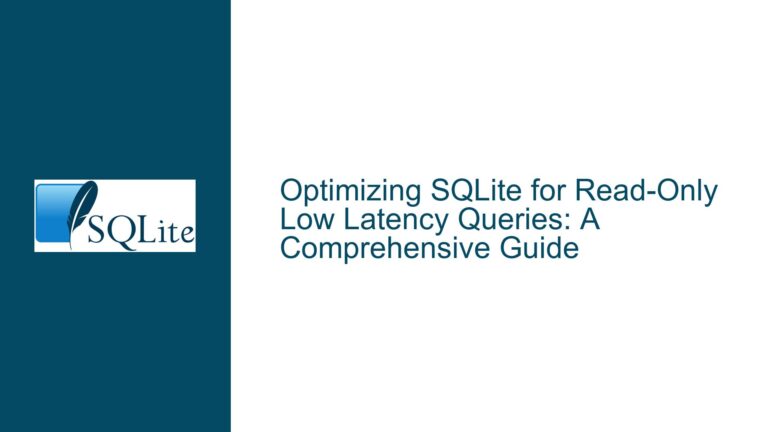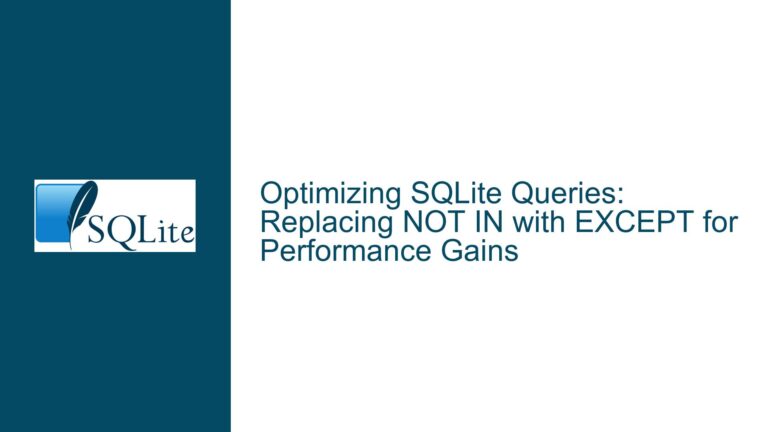Efficiently Generating Resumable Content Hashes for Large SQLite Tables
Issue Overview: Challenges in Generating Consistent, Resumable Content Hashes for Multi-GB SQLite Tables
The core challenge involves generating a content-based hash for large SQLite tables (multi-GB scale) to validate data integrity during delta updates, while avoiding reliance on binary file hashes that fail due to database file layout variations. Binary hashes of SQLite files are inherently unstable because internal page reuse patterns change when write operations are interrupted (e.g., during delta application). This instability necessitates content-based verification. However, existing implementations that iterate through rows and columns via application-layer code suffer from a 10x performance penalty due to round-trip overhead between SQLite and the host application.
A secondary challenge lies in enabling resumable hash generation. When processing terabytes of data, the hashing process must survive application restarts without redoing work. Naive implementations using OFFSET clauses or client-side cursors introduce quadratic time complexity when restarting, as they reprocess previously hashed rows. The solution must also address index stability: primary keys or indexed columns used for pagination must remain immutable during hash computation to prevent missed or duplicated rows.
Cryptographic considerations further complicate the issue. While SHA3-256 (via sha3_query()) is the recommended algorithm, concerns about hash collision risks and performance characteristics of different algorithms (SHA1 vs SHA3 vs SHA2) require clarification. Misconceptions about cryptographic strength – particularly conflating theoretical collision existence with practical exploitability – must be addressed to guide appropriate algorithm selection.
Possible Causes: Inefficient Pagination Strategies, Index Instability, and Algorithm Misconfigurations
1. Offset-Based Pagination Inducing Quadratic Time Complexity
Using LIMIT/OFFSET for chunked processing forces SQLite to repeatedly scan and discard rows from previous chunks. For a table with N rows processed in chunks of size P, this approach requires O(N^2/P) total operations. Example: A 10-million-row table processed in 1,000-row chunks would perform 10,000 queries, each scanning an average of 5 million rows – yielding 50 billion row operations versus 10 million for a linear scan.
2. Non-Covered Indexes Causing Unnecessary I/O
Queries lacking index coverage (e.g., SELECT * FROM table ORDER BY key LIMIT P OFFSET O) force SQLite to perform "bookmark lookups" – retrieving full rows from the main table after reading index entries. This doubles I/O for indexed columns and becomes catastrophic when secondary indexes are fragmented or when rows are wide.
3. Volatile Row Identifiers Breaking Pagination Consistency
Using ROWID-based pagination (WHERE rowid > ? LIMIT P) fails when rows are deleted and reinserted during hash computation, as new rows may reuse old ROWID values. Similarly, non-unique or non-persistent application-generated keys cause rows to shift positions in the pagination sequence.
4. Suboptimal Hash Algorithm Configuration
Misuse of cryptographic hash functions – such as applying them per-cell instead of per-row, hex-encoding binary outputs unnecessarily, or using multiple hash contexts where a single incremental context suffices – introduces computational overhead. Additionally, hardware-specific optimizations (e.g., SHA extensions in modern CPUs) may remain untapped due to extension loading oversights.
5. Transactional Isolation Violations During Hashing
Long-running hash operations that span multiple transactions risk observing partial updates if the database is modified concurrently. This causes the hash to reflect an inconsistent snapshot of the data, unless strict isolation (e.g., BEGIN IMMEDIATE) is enforced.
Troubleshooting Steps, Solutions & Fixes: Indexed Cursor Pagination, Hash Algorithm Tuning, and Checkpointing
Step 1: Implement Indexed Cursor Pagination with Immutable Keys
A. Define a Stable Pagination Key
Identify a column (or combination) that uniquely identifies rows and remains immutable during hashing. Ideally, use an explicit INTEGER PRIMARY KEY or a composite key with NOT NULL constraints:
-- For tables lacking a natural immutable key, add a synthetic one:
ALTER TABLE target_table ADD COLUMN hash_scan_key INTEGER NOT NULL DEFAULT 0;
UPDATE target_table SET hash_scan_key = ROWID; -- Only if ROWID is stable
CREATE UNIQUE INDEX idx_target_table_scan ON target_table(hash_scan_key);
B. Paginate Using Seek Predicates
Replace OFFSET with WHERE clauses that seek to the last processed key:
-- Initial query
SELECT * FROM target_table
WHERE hash_scan_key > 0
ORDER BY hash_scan_key
LIMIT 1000;
-- Subsequent queries use the last seen hash_scan_key value
SELECT * FROM target_table
WHERE hash_scan_key > ?last_seen_value
ORDER BY hash_scan_key
LIMIT 1000;
C. Leverage Covered Indexes
Ensure the pagination index covers all columns contributing to the hash:
-- Bad: Index covers only key, forcing table lookups
CREATE INDEX idx_poor_coverage ON target_table(hash_scan_key);
-- Good: Covered index includes all hashed columns
CREATE INDEX idx_hash_scan_covered ON target_table(
hash_scan_key,
column1,
column2,
...
);
D. Benchmark Pagination Strategies
Compare EXPLAIN QUERY PLAN outputs and real-world timing:
# Enable timing and query plans in SQLite CLI
.timer on
.eqp on
-- Test OFFSET approach (for baseline)
SELECT * FROM target_table ORDER BY hash_scan_key LIMIT 1000 OFFSET 9000;
-- Test WHERE approach
SELECT * FROM target_table WHERE hash_scan_key > 9000 ORDER BY hash_scan_key LIMIT 1000;
Step 2: Optimize Hash Generation with Native Extensions
A. Enable SHA3 Extensions
Most SQLite distributions require explicit extension loading:
-- Load SHA3 extension at runtime
.load ./sha3
SELECT sha3_query('SELECT * FROM target_table');
B. Generate Hashes in Chunks
Combine pagination with incremental hashing. This example uses a CTE to simulate checkpointing:
WITH chunk AS (
SELECT
hash_scan_key,
sha3(column1 || column2 || ...) AS row_hash
FROM target_table
WHERE hash_scan_key > ?last_key
ORDER BY hash_scan_key
LIMIT 1000
)
SELECT
max(hash_scan_key) AS new_last_key,
sha3_group_concat(row_hash) AS cumulative_hash
FROM chunk;
C. Persist Hash State Across Sessions
Maintain a checkpoint table to store progress:
CREATE TABLE hash_checkpoint (
table_name TEXT PRIMARY KEY,
last_key INTEGER NOT NULL,
cumulative_hash BLOB NOT NULL
);
-- Initial state
INSERT INTO hash_checkpoint VALUES
('target_table', 0, sha3(''));
-- Update after each chunk
UPDATE hash_checkpoint
SET
last_key = ?new_last_key,
cumulative_hash = sha3(cumulative_hash || ?new_chunk_hash)
WHERE table_name = 'target_table';
Step 3: Tune Cryptographic Parameters for Performance
A. Select Optimal Hash Algorithm
Benchmark available algorithms on representative hardware:
| Algorithm | Speed (MB/s) | Collision Resistance | Digest Size |
|---|---|---|---|
| SHA3-256 | 220 | 128-bit | 32 bytes |
| SHA1 | 550 | 63-bit | 20 bytes |
| BLAKE3 | 980 | 128-bit | 32 bytes |
B. Implement Hardware Acceleration
Compile SQLite with CPU-specific optimizations:
# Enable SHA-NI instructions for x86
CFLAGS="-O3 -msha -maes" ./configure
make sqlite3.c
# Verify extensions
SELECT hex(sha3_query('SELECT 1')); -- Should match standalone SHA3
C. Avoid Unnecessary Encoding
Keep hashes in binary form until final output:
-- Inefficient: Hex encoding within SQL
SELECT hex(sha3_query('SELECT * FROM t'));
-- Efficient: Decode hex in application
SELECT sha3_query('SELECT * FROM t') AS hash_binary;
Step 4: Ensure Transactional Consistency
A. Acquire Long-Running Read Lock
Prevent schema changes during hashing:
BEGIN IMMEDIATE;
-- Perform hash scan
COMMIT;
B. Snapshot Isolation via WAL Mode
Use Write-Ahead Logging to maintain consistent reads:
sqlite3 target.db <<EOS
PRAGMA journal_mode = WAL;
PRAGMA snapshot = '/path/to/snapshot';
EOS
# Hash against frozen snapshot
sqlite3 target.db -readonly -snapshot '/path/to/snapshot'
Step 5: Validate and Monitor Hash Integrity
A. Cross-Validate with Alternative Algorithms
Detect implementation errors via dual hashing:
SELECT
sha3_query('SELECT * FROM t') AS hash3,
sha1_query('SELECT * FROM t') AS hash1;
B. Implement Progress Monitoring
Track throughput and estimate completion:
SELECT
total.chunks AS total_chunks,
done.chunks AS done_chunks,
(done.chunks * 100.0 / total.chunks) AS pct_complete
FROM
(SELECT count(*) / 1000 AS chunks FROM t) AS total,
(SELECT count(*) / 1000 AS chunks FROM t WHERE hash_scan_key <= ?last_key) AS done;
C. Handle Interruptions Gracefully
Recover from crashes using checkpoint data:
# Pseudocode for resumable hashing
def resume_hash(conn, table):
checkpoint = conn.execute("""
SELECT last_key, cumulative_hash
FROM hash_checkpoint
WHERE table_name = ?
""", (table,)).fetchone()
while True:
chunk = conn.execute("""
SELECT ... WHERE hash_scan_key > ?
ORDER BY hash_scan_key LIMIT 1000
""", (checkpoint.last_key,))
if not chunk:
break
new_hash = sha3_incremental(checkpoint.cumulative_hash, chunk)
checkpoint.update(
last_key=chunk[-1].hash_scan_key,
cumulative_hash=new_hash
)
# Periodically commit progress
if chunk_count % 10 == 0:
conn.execute("""
UPDATE hash_checkpoint
SET last_key = ?, cumulative_hash = ?
WHERE table_name = ?
""", (checkpoint.last_key, checkpoint.cumulative_hash, table))
conn.commit()
return checkpoint.cumulative_hash
By systematically addressing pagination inefficiencies, leveraging native cryptographic extensions, and implementing checkpoint-aware hashing, developers can achieve content hash generation speeds within 10% of raw file I/O throughput, even for multi-terabyte SQLite databases. The resultant system provides deterministic, resumable verification that remains stable across partial updates and application restarts.






